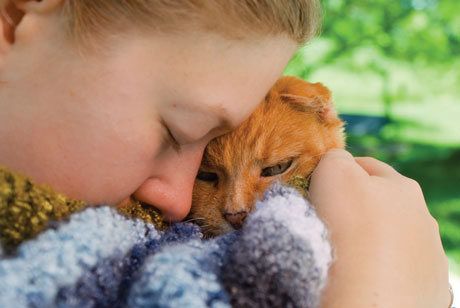 Whether expected or not, the death of a beloved family pet often leaves families feeling sad and unprepared. For families with young kids, a pet’s passing may be the first time parents discuss death with their children.
Whether expected or not, the death of a beloved family pet often leaves families feeling sad and unprepared. For families with young kids, a pet’s passing may be the first time parents discuss death with their children.
Few parents know how to approach this challenging topic, particularly with very young children. “Developmentally, children of this age do not understand the finality or permanence of death,” says Kate Munson, a Seattle counselor whose specialties include pet loss.
Munson urges parents to use straightforward and simple language when a pet dies. Parents can tell children, for example, “The pet’s body stopped working.” They should use concrete words like “dead, died or dying,” Munson says.
Seattle mom Dina Karant thought she was taking all the right steps when the family’s cherished greyhound died. The dog was old and sick, and Karant had been readying herself for his impending death. She prepared her 4-year-old daughter by explaining that the dog was very old and was struggling to move around.
When Garvey’s final day came, Karant asked her daughter, who was leaving for daycare, to give him a hug and a kiss.
When Karant (she’d told the daycare what was happening) picked up her daughter that afternoon, a teacher informed her that her daughter thought Garvey had “gone away.”
That’s when Karant realized she’d done a poor job of communicating the truth by using vague language such as “He will no longer be with us.” She had never actually said their dog was going to die that day.
It’s not their fault
Even with simple, direct, to-the-point information, parents can expect misunderstandings. Preschool-age children are still learning the forces of cause and effect, and may believe they’re responsible for their pet’s death. “If anything happens to a pet and it dies, the child may very well think that he or she did something wrong,” says Wallace Sife, Ph.D., a Brooklyn-based psychotherapist, author of The Loss of a Pet, and founder of the Association for Pet Loss and Bereavement . Reassure children they did nothing wrong, he stresses.
And don’t lie. “Resist the temptation to say the pet went to live with a family in the country,” says Ann R. Howie, a Lacey-area counselor with expertise in human-animal interaction. Concocting tall tales can create even more problems. Let’s say the child wants to visit the pet or asks why another family gets to keep it. Euphemisms such as “went to sleep” or “put to sleep” don’t work well, either. They can confuse kids (what does that really mean, after all?) and can cause them to fear going to sleep, Munson says.
What to share
While experts favor honesty and openness, pet euthanasia presents an exceptionally difficult challenge for parents. Some parents may choose not to go into detail with their children, but simply say that a pet died.
“Euthanasia is a difficult concept for adults to grasp, let alone young children,” Howie says. A child’s age and maturity level, as well as the pet’s health status, may dictate how much parents decide to share.
Bridget Lamp’s cherished family dog, Mudsy, had to be euthanized unexpectedly. The Seattle mom and her husband, Eldon Tam, told their young son that Mudsy died, but did not tell him precisely how. They knew that he would not be able to understand.
And while they did not share details, Lamp shared her emotions, crying openly with her son. “I explained I was crying because I felt very sad about Mudsy dying.”
First experience with death
The way parents handle the death of a family pet can have lasting effects.
“The first experience with death is usually with a pet,” Sife says. “It could be a turtle, it could be a goldfish, or it could be a dog or a cat.” And this first encounter “shapes how we will approach and view future deaths,” says Munson.
Seattle parents Sonya and Brad Senstra chose to be straightforward with their three sons when the family cat, Max, was at the end of his life. They explained to their boys, ages 6, 4 and 2, that they could help Max’s body stop hurting by taking him to the vet to die. The boys cried, made cards for their cat, and took turns petting and holding him.
The Senstras gave their older sons a choice, and the boys decided to go along to the vet’s office to say goodbye as Max was euthanized. The whole family was very sad, and still misses their dear cat Max, but Sonya came away satisfied with their experience. For her, it was a window into the cycle of life.
“I'm actually surprised how letting the boys choose and participate seems to have helped them understand the whole situation,” she says.
Freelance writer Nancy Chaney lives in Seattle with her husband and 3-year-old son.
 Helping kids deal with the grief from the death of a pet
Helping kids deal with the grief from the death of a pet
• Don’t feel you need to hide your own sadness; children learn from and model adults’ emotions.
• Be open to providing comfort and answering questions about the pet’s death; these needs may pop up at any time, even long after the pet has died.
• If children show interest, help them draw pictures of their
• pet or make a scrapbook of memories. Talk with them during the process.
• Establish a family remembrance of your pet; a specific place, a special time or something you do together as a family to memorialize your lost friend.
• Take it slowly when considering a new pet; make sure everyone is ready.
Sources: Ann R. Howie; Kate Munson; Wallace Sife, Ph.D.











